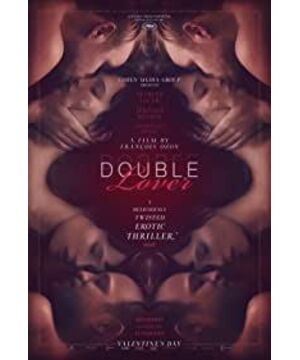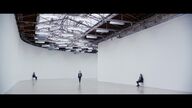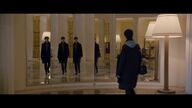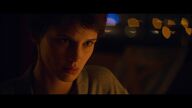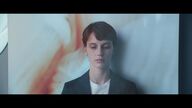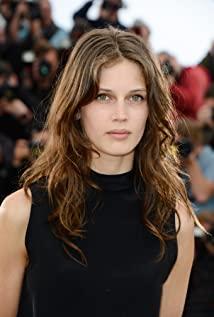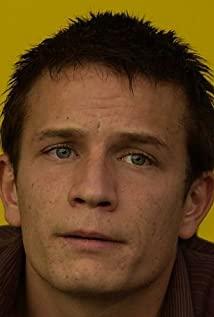As the most famous director of the three European awards, François Ou Jong has risen to fame on the one hand and has been poised for more than ten years as a quasi-master. On the other hand, he has mixed reputation in the selection of themes and content. The appraisal is unstable. Even as a fan of his many years, every new film is still in fear. Last year's clear and clear black-and-white film "Franz", the comments were still polarized. For this film with classical aesthetic elements, fans often described it as "banal and boring." As if responding to the expectations of movie fans, the "Double-Sided Lover" launched this year is full of essays in terms of horror, as if deliberately to satisfy the fans' expectations, but the gap between the front and rear parts of the film is huge, which makes it impossible to justify, and the overall impression is reduced. . As a highlight of its audiovisual language, in fact, its source is also a tribute (imitate?) element everywhere. Whether it is a repetition of the erotic drama of his previous works or the imprint of many famous shadows, it is regrettable.
The illusory world of Jinghua Shuiyue
The most outstanding feature of this film is undoubtedly the use of mirror images (and this method has been abused). Mirrors have always been loved by directors as an important prop for reflecting the inner subconscious and presenting unrealistic spaces. "Double-faced Lover" takes "twin" as the basic concept, and the mutual reflection between characters dominates the overall situation. With this idea, Cronenberg has already shot a higher rank "Evil Buckle". According to Lacan's mirror image theory, the mirror image is an illusion when we observe the world. It is based on the misunderstanding of other people's eyes. After transformation and reflection, it becomes a "mind image". After this process, the reflection in the mirror constitutes the subject of the self. We might as well put this theory in the interpretation of the film, although Ou Rong is more willing to put it into the stacking of various symbols, but the goal is not to explain this theory deeply.
Chloe often feels abdominal pain, initially thought it was a physical illness, and then identified it as a psychological problem, until the end revealed that it was a vegetation (the parasitic fetal alienation of the twin sister). Under the dual effects of physiology and psychology, she used her mental consciousness to derive the entity twin sister Sandra. She is full of yearning and fearful contradiction with this heterogeneous sister. This contradiction stems from her lack of maternal love. The resulting impotence of love (another subject of abuse). And Paul, who turned from a psychologist to a lover, also copied a twin brother Louis in her mind. When Chloe and Paul had sex, Louis and Sandra also appeared quietly. The reflection in the mirror is really impressive. Horrified.
Sandra was originally a product of imagination, but as a "physical character" in the play, he also appeared on the scene, appearing as the victimized prey of Louis and Paul in the past. Chloe pushes in the door, and the camera moves from the mirror to Sandra on the bed. This scene is very much like Hitchcock's "Scary", the withered Sandra transforms into Chloe himself in a trance, and the typical "mirror" is reversed to "subject." Sandra’s mother explained the behavior of Louis and Paul at the time (the same as Chloe's entanglement between them now), debunking Chloe’s “you like this yourself”, and this mother is Chloe’s mother in reality. . Therefore, this scene is very critical. The main body and mirror image of several groups of characters are clearly explained, so that the audience can connect many details and connect the cause and effect.
Another group of mirror figures is the psychiatrist Agnès Wisler, whom Chloe has never met. We will be surprised to find that it is his gynecologist (both appearing on both sides). The physical and psychological healers overlap, and also from the side. It implies that Chloe's imaginary world is beautiful.
In addition to the use of mirror reflection to create illusions, split-screen techniques also frequently appear in the film, including when Chloe talks to himself and when he is on the phone with Louis, he emphasizes his split consciousness. Sandra is her initial clone and variant, and most of the illusions later secreted by her brain are distortions of subjective consciousness (real life). The sharp and direct Louis, the first scene is a phantom-there are fake flowers in the flowerpot outside the clinic and no soil (see Paul's real flowers and real soil), sharply pointed out that she has sexual fantasies about twins (abdominal neoplasms) In reality, her sex is cold, and her imagination rekindles her excitement), and at the same time, she claims that she is jealous of her twin brother (which is precisely Chloe’s secret feelings for Sandra), and Louis is the deepest part of Chloe’s heart. The spokesperson, he vented her unspoken secrets in place of her. His face was always half-open and hidden in the dark, until he declared that "your secret is his (Paul's) secret", Sandra and Chloe, Louis and Paul, the mirror image and subject of the two twins, overlap.
"God created night time, armed with dreams and mirrors, in order to make people understand that he himself is just a reflection." This is a famous poem by Borges. He has always been afraid of mirrors because mirrors can be infinite. Reproduction, because the mirror "looks at us all the time", because "the mirror shows us another face", because "I am afraid that the mirror is the true face of my soul". These can be used as a starting point to interpret the film.
Numerous and sharp visual styling
This time, Ou Rong not only returned to his masterful erotic theme, but also took a slant in the visual presentation. The combination of eroticism and thriller, and the reversed plot trend, all have quite genre elements. But if we go through the details carefully, we will find that these sources are not unfamiliar. The popular opening is not too big compared to Alan Girodi, and the vagina turns into eyes. Shouldn’t it be reminiscent of the montage of throwing bones into spaceships in "2001: A Space Odyssey"? Some fans think of Bunuel’s "An Andalu Dog", where the dark clouds cut the moon and the blade cuts the eyeball alternately, and the same technique is used. When Chloe walked into Louis's studio, he passed through a row of mirrors, reflecting N shadows. This scene is almost the same in Varda's "A Thousand Faces Treasure Gold" and Orson Wells's "Miss Shanghai" . As for the scene where the twins are holding hands, almost every fan will instantly think of Kubrick’s "The Shining"... Perhaps these are one of the reasons why I am more disappointed in this film. In addition to repeating his past self, Ou Rong pays tribute There are too many ingredients, which is not a blessing for a mature director.
Fortunately, the composition of the film is quite beautiful, and the degree of regularity almost makes people think that when watching Wes Anderson, symmetry is emphasized everywhere, and the purpose of serving the mirror structure is self-evident. I love the scene where Chloe sits in the museum. With a large white background, she is lonely and cold. She exudes a lonely breath in the center of the frame. She is surrounded by the "blood and flesh" paintings around her. She is indulged in spiritual roaming, but her body is confined. At this point, consciousness flew beyond the boundless. This scene provides at least three pieces of information: the source of the split consciousness, the impact of the alienated work environment (her own job is to monitor visitors, but she is the one being monitored), and the museum's "blood&flesh" theme exhibition in the visual styling The spiritual and physical union/separation created by the above.
When Chloe walked into Paul and Louis's clinic, he had to walk up a spiral staircase, and the camera shot from the bottom up, which had a dizzy effect. The spiral staircase has been used extensively since the expressionist period of the silent film period to show the uncontrolled psychology of the characters. In Hitchcock's "Victorius", the spiral staircase looking down deforms and reaches the pinnacle of dizziness. . The process of Chloe’s psychotherapy is the process of accepting self-hypnosis. In the dialogue scene between her and Louis, the two are in the front and back scenes, one is talking in the foreground, and the other is in the defocused position in the back scene. The whole composition is full of blurry. Blooming sensation.
I want to talk about the dark line placement
The mysterious and unpredictable in the first half is in sharp contrast with the weak and pale release at the end. The audience is easily disappointed by the grand layout of the grand structure, and finally ended up in such a mediocre explanation, which gives people a sense of haste. The script cannot justify itself and exposes the creation. Lack of completion. Although the last shot is still horrifying, what other functions can it have besides repeating the same mistakes? Does Ou Rong want to overturn all previous reversals with the so-called open ending to prove that all this is just another narrative trick?
That’s right, the first two thirds of the film, just like the secret expectations when watching "Franz", I have been waiting for the creation of a larger pattern and the closing of multiple clues. The most anticipated thing is the neighbors. And cat set. In the interview, Ou Rong claimed that Milo appeared purely because of his love for cats. This is true. There are also two cats in "Chasing Love to Heaven". However, the functions of tortoiseshell cats and Milo in this film do not stop there. The reference to cats as human beings and the sense of voyeurism through cat eyes are all filled with Hitchcock-style suspense. Milo's disappearance finally returned to Chloe's mother's sweater as a brooch, confirming once again that this was only an illusion, perhaps Chloe had never had a cat.
The role of the neighbor who is closely related to the cat is possessed by "Rosemary’s Baby", including the bridge section where the cake is delivered. All kinds of ambiguous looks and tone, and unexpected behaviors have always given the audience a certain expectation. This kind of expectation is exactly the same as in "Franz"-in the end nothing happened, was it not done enough, or was it a silly pen? From the perspective of narrative duties, there is no specific function, but it contributes to the atmosphere. The heroine Chloe’s short hair and skinny image fit Mia Farrow very well, and it’s hard to say that Ou Jong has not been influenced by Polanski. These dark lines, which are still waiting to be talked about, are ambushing in the aftermath of the mainstream plot and staring at them, becoming another landscape.
Published in "Watching Movies" 2017.11
View more about Double Lover reviews


